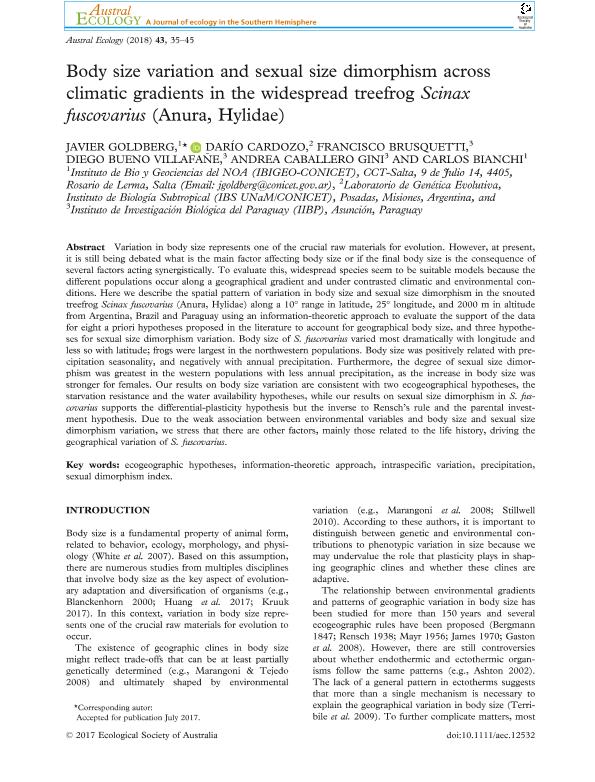Artículo
Body size variation and sexual size dimorphism across climatic gradients in the widespread treefrog Scinax fuscovarius (Anura, Hylidae)
Goldberg, Francisco Javier ; Cardozo, Dario Elbio
; Cardozo, Dario Elbio ; Brusquetti, Francisco; Bueno Villafañe, Diego; Caballero Gini, Andrea Natalia
; Brusquetti, Francisco; Bueno Villafañe, Diego; Caballero Gini, Andrea Natalia ; Bianchi, Carlos Luis
; Bianchi, Carlos Luis
 ; Cardozo, Dario Elbio
; Cardozo, Dario Elbio ; Brusquetti, Francisco; Bueno Villafañe, Diego; Caballero Gini, Andrea Natalia
; Brusquetti, Francisco; Bueno Villafañe, Diego; Caballero Gini, Andrea Natalia ; Bianchi, Carlos Luis
; Bianchi, Carlos Luis
Fecha de publicación:
02/2018
Editorial:
Wiley Blackwell Publishing, Inc
Revista:
Austral Ecology
ISSN:
1442-9985
Idioma:
Inglés
Tipo de recurso:
Artículo publicado
Clasificación temática:
Resumen
Variation in body size represents one of the crucial raw materials for evolution. However, at present, it is still being debated what is the main factor affecting body size or if the final body size is the consequence of several factors acting synergistically. To evaluate this, widespread species seem to be suitable models because the different populations occur along a geographical gradient and under contrasted climatic and environmental conditions. Here we describe the spatial pattern of variation in body size and sexual size dimorphism in the snouted treefrog Scinax fuscovarius (Anura, Hylidae) along a 10° range in latitude, 25° longitude, and 2000 m in altitude from Argentina, Brazil and Paraguay using an information-theoretic approach to evaluate the support of the data for eight a priori hypotheses proposed in the literature to account for geographical body size, and three hypotheses for sexual size dimorphism variation. Body size of S. fuscovarius varied most dramatically with longitude and less so with latitude; frogs were largest in the northwestern populations. Body size was positively related with precipitation seasonality, and negatively with annual precipitation. Furthermore, the degree of sexual size dimorphism was greatest in the western populations with less annual precipitation, as the increase in body size was stronger for females. Our results on body size variation are consistent with two ecogeographical hypotheses, the starvation resistance and the water availability hypotheses, while our results on sexual size dimorphism in S. fuscovarius supports the differential-plasticity hypothesis but the inverse to Rensch's rule and the parental investment hypothesis. Due to the weak association between environmental variables and body size and sexual size dimorphism variation, we stress that there are other factors, mainly those related to the life history, driving the geographical variation of S. fuscovarius.
Archivos asociados
Licencia
Identificadores
Colecciones
Articulos(IBIGEO)
Articulos de INST.DE BIO Y GEOCIENCIAS DEL NOA
Articulos de INST.DE BIO Y GEOCIENCIAS DEL NOA
Citación
Goldberg, Francisco Javier; Cardozo, Dario Elbio; Brusquetti, Francisco; Bueno Villafañe, Diego; Caballero Gini, Andrea Natalia; et al.; Body size variation and sexual size dimorphism across climatic gradients in the widespread treefrog Scinax fuscovarius (Anura, Hylidae); Wiley Blackwell Publishing, Inc; Austral Ecology; 43; 1; 2-2018; 35-45
Compartir
Altmétricas



